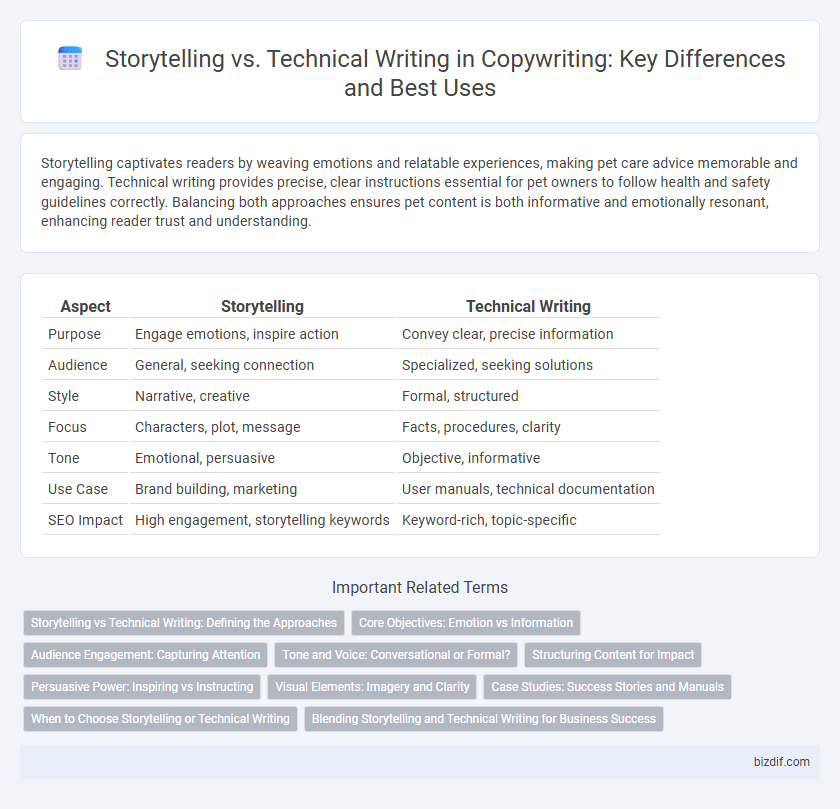Storytelling captivates readers by weaving emotions and relatable experiences, making pet care advice memorable and engaging. Technical writing provides precise, clear instructions essential for pet owners to follow health and safety guidelines correctly. Balancing both approaches ensures pet content is both informative and emotionally resonant, enhancing reader trust and understanding.
Table of Comparison
| Aspect | Storytelling | Technical Writing |
|---|---|---|
| Purpose | Engage emotions, inspire action | Convey clear, precise information |
| Audience | General, seeking connection | Specialized, seeking solutions |
| Style | Narrative, creative | Formal, structured |
| Focus | Characters, plot, message | Facts, procedures, clarity |
| Tone | Emotional, persuasive | Objective, informative |
| Use Case | Brand building, marketing | User manuals, technical documentation |
| SEO Impact | High engagement, storytelling keywords | Keyword-rich, topic-specific |
Storytelling vs Technical Writing: Defining the Approaches
Storytelling in copywriting captivates audiences by weaving emotions and narratives that create memorable brand experiences, while technical writing prioritizes clarity and precision to convey complex information effectively. Storytelling uses character development and plot to engage readers on a personal level, whereas technical writing employs structured formats, jargon, and detailed instructions to ensure comprehension and usability. Understanding these distinct approaches allows copywriters to tailor content strategies that balance emotional appeal with informative accuracy.
Core Objectives: Emotion vs Information
Storytelling in copywriting centers on evoking emotions and creating a relatable narrative that connects with the audience on a personal level. Technical writing prioritizes clarity and precision, delivering detailed information to educate or instruct readers effectively. The core objective of storytelling is to inspire and engage, while technical writing aims to inform and ensure understanding.
Audience Engagement: Capturing Attention
Storytelling captivates audiences by weaving emotional narratives and relatable characters, creating immersive experiences that foster deep connections. Technical writing prioritizes clarity and precision, delivering factual information efficiently to support quick comprehension and practical application. Effective audience engagement balances narrative appeal with informative content, tailoring communication to meet readers' expectations and needs.
Tone and Voice: Conversational or Formal?
Storytelling in copywriting employs a conversational tone and authentic voice to engage audiences emotionally and build connection, often using relatable language and personal anecdotes. Technical writing prioritizes a formal tone and objective voice, delivering clear, precise information to ensure understanding and credibility. Balancing tone and voice according to purpose and audience enhances the effectiveness of both storytelling and technical writing strategies.
Structuring Content for Impact
Storytelling emphasizes a compelling narrative arc with a clear beginning, middle, and end, engaging readers emotionally and driving retention. Technical writing prioritizes clarity and precision, using structured formats like numbered lists, headings, and bullet points to enhance usability and quick reference. Balancing creativity with clear organization maximizes content impact and reader comprehension in both domains.
Persuasive Power: Inspiring vs Instructing
Storytelling in copywriting leverages emotional engagement and vivid narratives to inspire action and create a memorable brand connection. Technical writing emphasizes clarity and precision, providing step-by-step instructions that guide readers to make informed decisions. The persuasive power of storytelling lies in its ability to evoke feelings and motivate, while technical writing persuades through logic and factual accuracy.
Visual Elements: Imagery and Clarity
Storytelling leverages rich visual elements and vivid imagery to evoke emotions and create immersive experiences that resonate with readers on a personal level. Technical writing prioritizes clarity and precision, using diagrams, charts, and straightforward visuals to enhance comprehension and convey complex information effectively. Combining storytelling visuals with technical clarity can optimize content engagement and understanding.
Case Studies: Success Stories and Manuals
Case studies in copywriting leverage storytelling to showcase success stories that engage readers by highlighting real-world applications and emotional impact. Technical writing focuses on creating clear, concise manuals that provide step-by-step instructions, ensuring user comprehension and efficient problem-solving. Combining storytelling elements with technical accuracy enhances the effectiveness of both success stories and instructional content.
When to Choose Storytelling or Technical Writing
Choose storytelling when the goal is to engage, persuade, or build an emotional connection with the audience by weaving narratives that highlight human experiences or brand values. Opt for technical writing when the objective is to convey complex information clearly and precisely, such as instructions, specifications, or product details requiring accuracy and clarity. Assess the audience's needs and the purpose of the content to determine whether an immersive story or straightforward explanation will achieve better communication results.
Blending Storytelling and Technical Writing for Business Success
Blending storytelling and technical writing enhances business communication by making complex information more relatable and engaging. Storytelling humanizes technical content, boosting reader retention and emotional connection, while technical writing ensures clarity and precision. This integrated approach drives customer trust, improves product understanding, and strengthens brand identity.
Storytelling vs Technical Writing Infographic

 bizdif.com
bizdif.com